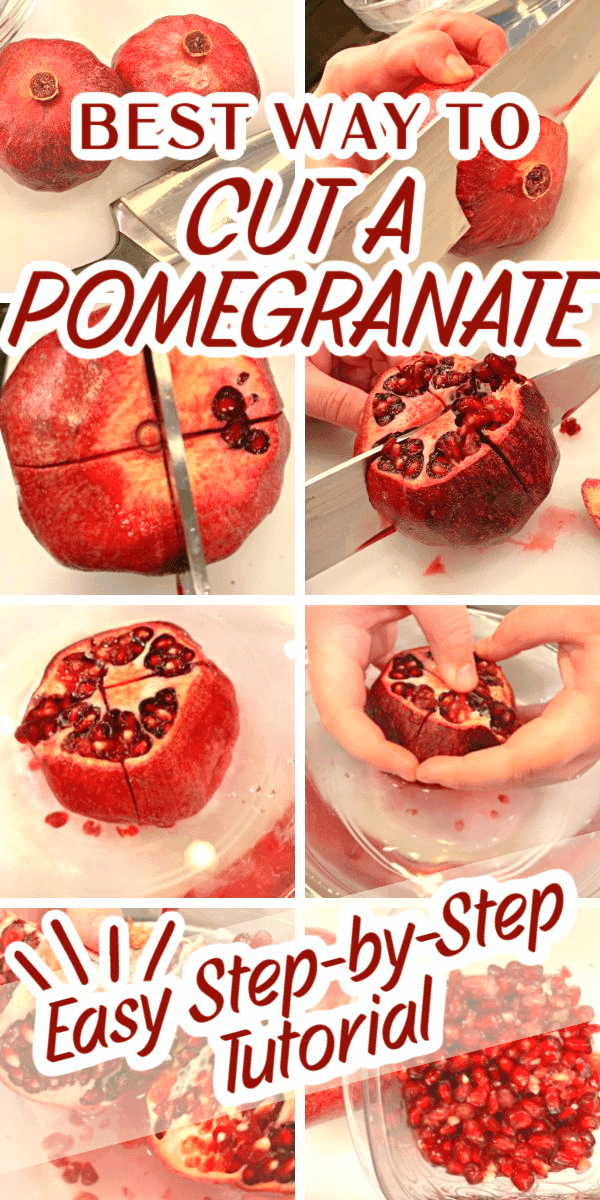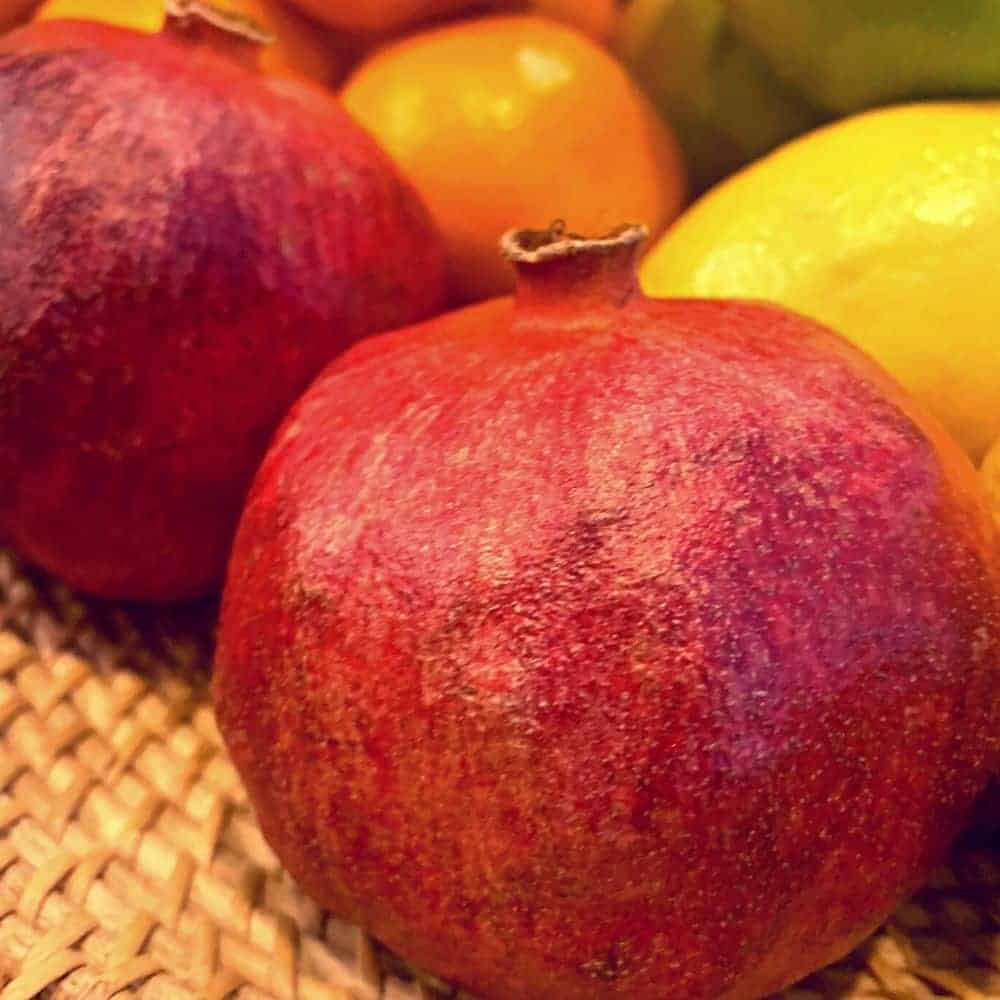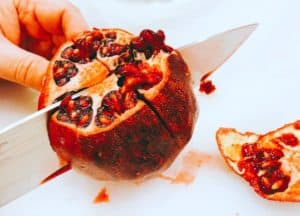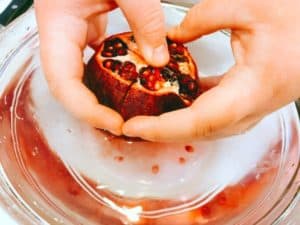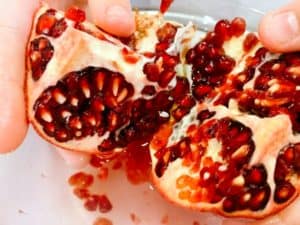Wondering how to cut open pomegranate easily and how to eat pomegranate? Full tutorial on how to cut and de-seed a pomegranate, eating pomegranate, and pomegranate recipe ideas. Learning how to open a pomegranate with your hands is super fun food kids activities for holidays and cooking project with kids! Use these pomegranate eating tips for a healthy fruit snack for kids and for easy fruit recipes (perfect for holiday foods, too) and other ideas on what to do with pomegranate seeds.
How To Cut Open Pomegranate (Easiest Way!)
Ever wondered how to cut, de-seed, and eat a pomegranate? If you’ve never had fresh pomegranate, you (and the kids!) are in for a treat. It’s a healthy snack to eat on its own, great for holiday recipes, and easy to use in dishes and pomegranate recipes! But first, you have to open pomegranates (and that can be intimidating at first!).
What is the best way to cut a pomegranate?
The best way to cut a pomegranate is to score the pomegranate on the top, submerged the pomegranate in water, and pry apart the pomegranate pieces. Then, you can easily scoop the pomegranate arils right into the water to drain and eat later.
How To Open Pomegranate In Water:
You’ll need:
- Pomegranates
- Large bowl of water
- Cutting board
- Sharp knife
- Bowl or container (to put the seeds in)
(Get our full directions on how to prep a pomegranate and how to cut a pomegranate in water printable directions below. Keep Scrolling for how to open a pomegranate hack ideas and more information on how to open pomegranate at home!)
Do pomegranate seeds need to be refrigerated?
Yes, pomegranate seeds should be refrigerated once a pomegranate has been cut and the arils and seeds removed. Place them in an airtight container for the pomegranate arils and seeds to last for one week (maybe a little more).
Opening a pomegranate can be… intimidating.
Which part do you eat?
Which part do you discard?
Are pomegranate seeds poisonous?
GAH! So many questions!
Before we get to how to cut pomegranate in water (and how to eat a pomegranate), let’s answer some of these common questions.
What are pomegranates?
Pomegranates are fruits full of edible arils, the pulpy part around the seeds. Pomegranates come from the Mediterranean region.
When are pomegranates in season?
Pomegranates are in season around late October into early November. You’ll start seeing them show up in the grocery store around then. They’re great to incorporate into your fall fun or holiday recipes! So, don’t miss these delicious fruits and pomegranate season!
How To Tell If A Pomegranate Is Ripe
How do you know when a pomegranate is ready to eat? A pomegranate is ripe and ready to eat when the fruit appears more square (and less round) and is flatter on the ends. (You can feel for the flat sides.) Also, a ripe pomegranate will feel heavier than pomegranate fruits that aren’t ripe. Pomegranates that are ripe are full of juice, which means the perfect pomegranate!
(Testing the weight of the fruit against each other is another great way to see if they are ripe.)
What is the aril of a pomegranate?
Pomegranate arils are the red, fleshy part around each seed. They are a combination of a sweet and tart fruit taste. You can eat the arils and the seeds that are in the arils.
Arils, or arillus, are not just specific to pomegranates.
How do you eat pomegranate?
You only eat the red arils (and the seeds if you want). You don’t eat the outer peel, white pith (white membrane) / spongy inner flesh or the outside of the pomegranate. To eat the pomegranate, remove the top of the pomegranate, and score pomegranate in a cross (shallow cuts). Pull apart sections and then remove the arils and seeds, which can be eaten fresh or added to recipes. Scoop out the remaining seeds (juicy arils) and discard the other parts of the pomegranate (white part and outer skin, etc.).
Are you supposed to eat the seeds of a pomegranate?
You can eat the seeds of a pomegranate, if you like. The juicy pulp around the crunchy seed is called the aril and is the part that most people suck from the seed, but many people eat the seeds too.
TIP: You don’t have to learn how how to open pomegranate seeds. The juicy pulp can be sucked from the pomegranate seed and seed discarded.
Is it safe to eat pomegranate seeds?
Yes, the crunchy pomegranate seeds inside the pulpy arils are perfectly safe to eat. The arils, or the juice-filled pulp, is difficult to remove from the seed, but you could spit the seeds out after eating the arils.
Pomegranate seeds are a perfect addition to a Bethlehem dinner!
How To Use Pomegranate Seeds
What goes well with pomegranate?
You can eat the pomegranate arils (and seeds) alone (with a spoon right from the fruit!), or you can use them in a variety of dishes and recipes!
How to eat pomegranate seeds:
- Oatmeal
- Cold cereals
- Yogurt
- Salads
- Smoothies
- Cheese platters
- Drinks
- Holiday or festive dips
- Desserts
- Spread on bread or crackers
Pomegranate Recipes Ideas
- Swap out the cranberries in this holiday dip recipe and add pomegranate seeds instead!
- Sprinkle this fall / winter salad recipe with pomegranate seeds for extra flavor.
- Top this fun fruit salad recipe for kids with pomegranate seeds.
Want more pomegranate recipes and ideas? Grab a pomegranate cookbook!
How To Store Pomegranate Seeds
Once you cut your pomegranate and remove the seeds, you should scoop them in an airtight container. Then, store the seeds and arils in the refrigerator for a couple of weeks.
Can Pomegranate Seeds Be Frozen
Yes! Pomegranates seed arils can be frozen for longterm storage. You can freeze pomegranate seeds for up to one year in an airtight container (like a freezer bag).
OK!
Let’s get to how to cut a pomegranate and eat it!
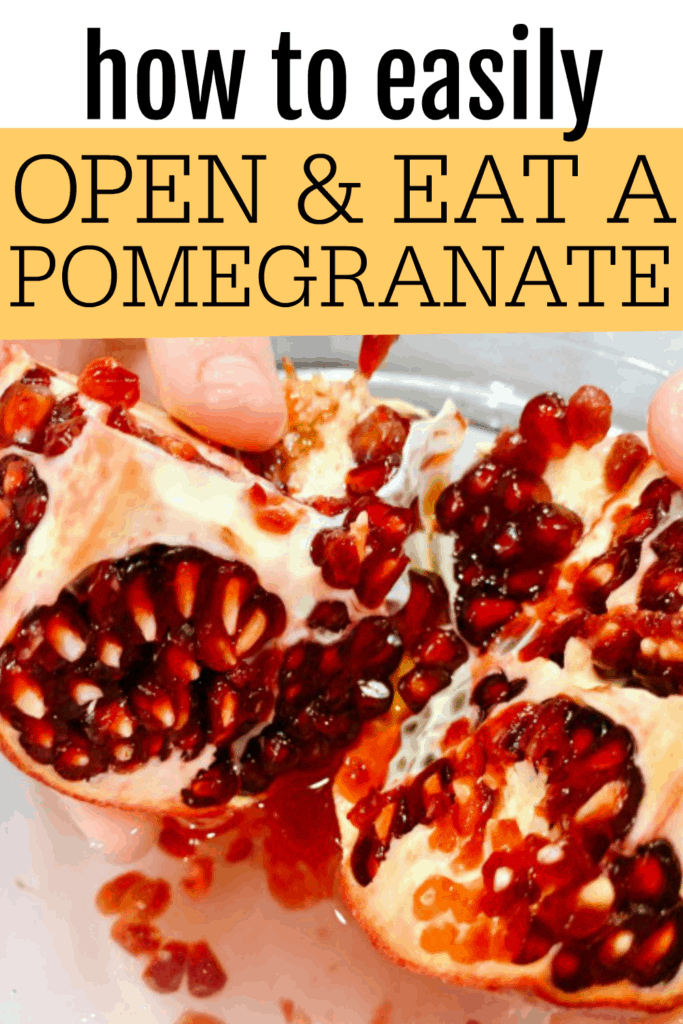
How To Cut Pomegranate Easily and Safely
If you’re wondering what is the easiest way to cut a pomegranate, this is it! It is also a super fun activity for kids to open and de-seed pomegranates, so add it to your ideas for winter months activities or Christmas recipes for kids.
IMPORTANT RECIPE TIP: Pomegranate juice stains and you may create a big juicy mess! The pomegranate juice is very red and can stain, so be careful what you’re wearing when you cut a pomegranate (and it squirts — we splattered two shirts in the process!). Also, protect your kitchen counter with a cutting board.
And, YES! You can juice pomegranates and drink that yummy pomegranate juice!
It can make a mess, so prepare your surfaces and clothes for that. (For projects like this I find those disposable kid aprons helpful!) Kids will be sticking their hands into the red juice and water to get the seeds out the bottom of the bowl.
Some people have asked how to open a pomegranate without making a mess.
I’m not really sure there is a cleanest way to open pomegranates. There are different ways, but this water method is definitely one of the easy methods.
(And, my daughter had a lot of fun
Also, you will need to use a sharp knife (not a paring knife) on a cutting board, so we definitely recommend that parents do the cutting for this cooking project with kids.
REMEMBER: The good stuff is made up of the juicy seeds (and not other parts of the fruit).
Here’s how to prep a pomegranate for eating these yummy ruby red seeds the easy way. Our step-by-step guide includes pictures to walk you through the easy steps.
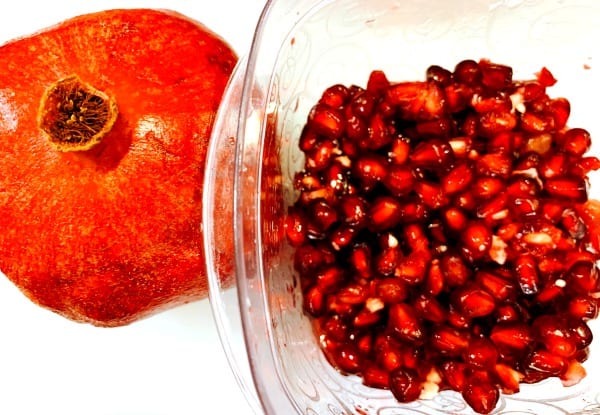
Pomegranate How To Open
Equipment
- Knife
- Cutting board
- Big bowl with cold water
- Aprons
Ingredients
- Pomegranate
Instructions
- CUT OFF THE TOP. How to prepare pomegranate: Find the top with the "bellybutton" (what my daughter calls the "stem" part) side. Slice off the top, about 1/4-inch. (Don't miss any seeds in the part you cut off! Be sure to scoop them out!)
- SCORE THE POMEGRANATE: On the top where you sliced it, cut a "cross" a little ways down into the fruit. This will help you section the pomegranate.
- SUBMERGE THE POMEGRANATE INTO THE BOWL OF WATER. While in the water, gently pry apart the sections of the pomegranate where it is scored. Work through each section and scoop out all the seeds into the water. (Discard the peel and white spongy inside.)
- Remove arils/seeds from water and store in an airtight container in the refrigerator.



